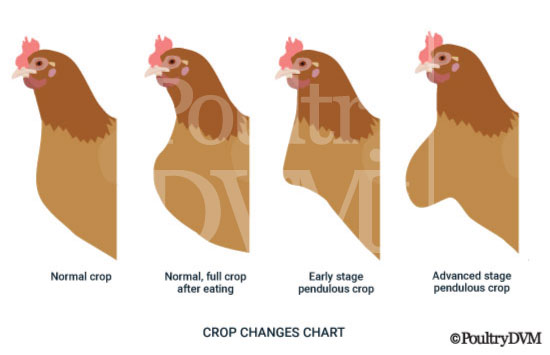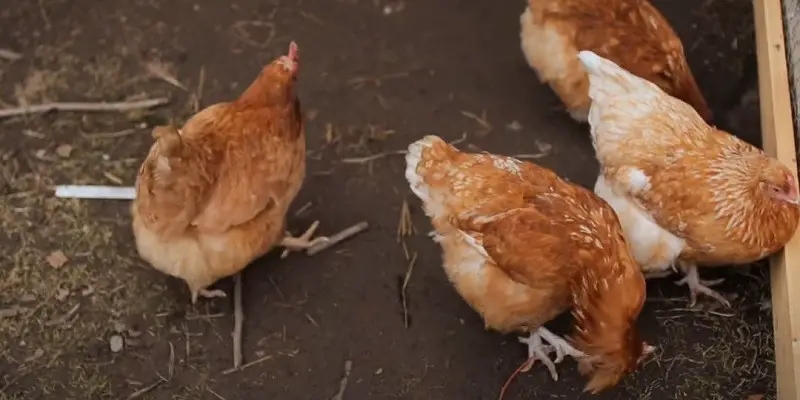An impacted crop in chickens can be fatal if not treated promptly. If left untreated, a chicken can live for only a few days with an impacted crop.
Chickens are prone to developing impacted crops, a condition where food becomes trapped in the crop and cannot pass through the digestive system. This can lead to discomfort, reduced appetite, and even death if not addressed. It’s crucial for chicken owners to recognize the signs of an impacted crop and seek veterinary care to ensure the well-being of their flock.
Understanding the causes and symptoms of an impacted crop, as well as the necessary steps for treatment, can help chicken owners safeguard their birds’ health and longevity. Let’s explore how to identify, address, and prevent impacted crops in chickens to ensure their continued well-being.
The Anatomy Of A Chicken’s Crop
A chicken’s crop can become impacted, leading to potential health issues. If left untreated, an impacted crop can drastically reduce a chicken’s lifespan. It’s essential to understand the anatomy of a chicken’s crop and seek prompt veterinary care to ensure the bird’s well-being.
The crop is an essential part of a chicken’s digestive system. It is a pouch located at the base of the chicken’s neck, serving as a storage compartment for food before it moves to the chicken’s stomach for digestion. The function of the crop, its symptoms when impacted, and the potential impacts on a chicken’s health are crucial for every poultry owner to understand and monitor.
Function Of The Crop
The primary function of the crop is to temporarily store ingested food before it moves on to the stomach for digestion. It allows chickens to eat quickly and then digest their food slowly throughout the day, thereby providing a sustained energy source. The crop also softens and moistens the food through the secretion of digestive enzymes, aiding in the digestion process later on. Moreover, it plays a crucial role in providing food for newly hatched chicks, as the hen often regurgitates food from the crop to feed its offspring.
Symptoms Of An Impacted Crop
Recognizing the symptoms of an impacted crop is fundamental for timely intervention. When a chicken’s crop is impacted, it may exhibit signs of distress, including decreased appetite, lethargy, weight loss, and a visibly swollen or firm crop. Additionally, affected chickens may regurgitate undigested food, have foul-smelling breath, or display signs of discomfort when palpating the crop.
It’s important to note that an impacted crop can be caused by various factors such as overconsumption of long, fibrous material, inadequate grit to aid digestion, or an underlying health issue. Failure to address an impacted crop promptly can lead to serious health complications and even endanger the chicken’s life.
Maintaining the health of a chicken’s crop is crucial for their overall well-being. Understanding the function and potential issues related to the crop empowers poultry owners to provide adequate care and take necessary actions to prevent and address potential problems. Regular monitoring of the crop’s condition and immediate intervention when symptoms arise are vital for ensuring the health and longevity of chickens.
Factors That Influence A Chicken’s Survival
When a chicken suffers from an impacted crop, several factors play a crucial role in determining its survival. Understanding these factors can help poultry keepers make informed decisions to support the chicken’s recovery.
Duration Of The Impaction
The duration of the impaction has a significant impact on a chicken’s survival. Prolonged impaction can lead to complications such as infection and tissue necrosis, reducing the chances of recovery. Immediate intervention is crucial to prevent long-term repercussions.
Severity Of The Impaction
The severity of the impaction directly affects the chicken’s well-being. Severe impactions can cause discomfort, inhibit normal feeding behavior, and lead to overall weakness. Prompt assessment and treatment are essential to mitigate the impact of severe impactions.
Impact Of Age And Overall Health
Age and overall health are critical determinants of a chicken’s ability to recover from an impacted crop. Younger and healthier chickens may have a better chance of survival, as their bodies can withstand the stress of the impaction and subsequent treatment more effectively.
Treatment Options And Interventions
When a chicken suffers from an impacted crop, timely treatment is crucial to ensuring the bird’s well-being. Understanding the appropriate treatment options and interventions can make a significant difference in their recovery. Here, we delve into the various methods to address an impacted crop in chickens, under differing scenarios.
Dietary And Lifestyle Adjustments
Implementing dietary and lifestyle adjustments can often aid in addressing an impacted crop in chickens. These adjustments may include:
- Feeding the chicken small, frequent meals to prevent overeating.
- Offering grit or coarse materials to aid in digestion.
- Avoiding fibrous vegetation and ensuring a balanced diet.
Veterinary Procedures And Medications
Veterinary intervention is crucial when a chicken’s impacted crop requires professional care. Treatment options may include:
- Manual crop massage to help break up the blockage.
- Administration of medications, such as laxatives or antibiotics, as prescribed by a veterinarian.
- Possibly, surgical intervention in severe cases, performed by a qualified avian veterinarian.
Home Remedies And Preventive Measures
Alongside professional treatment, there are home remedies and preventive measures that can positively impact a chicken’s recovery. Some of these measures include:
- Encouraging regular exercise and natural foraging behaviors to aid digestion.
- Providing access to clean water at all times to ensure optimal hydration.
- Regular crop checks to identify any issues at an early stage.

Credit: poultrydvm.com
Monitoring And Care For Chickens With Impacted Crops
When it comes to the health of your flock, monitoring and providing care for chickens with impacted crops is crucial. Impacted crop, a condition where a chicken’s digestive system becomes blocked, can lead to serious health issues if not addressed promptly. In this article, we’ll delve into how to observe the behavior and appetite of your chickens, provide supportive care and nurturing, and stress the importance of regular check-ups and follow-up treatment for chickens with impacted crops.
Observing Behavior And Appetite
Recognizing the symptoms of an impacted crop is the first step in providing care for affected chickens. Be vigilant for signs such as lethargy, decreased activity, reluctance to move, and reduced appetite. If you notice any of these signs, it’s essential to take immediate action to prevent further complications. Regularly observe their behavior and appetite to assess any changes and act accordingly.
Providing Supportive Care And Nurturing
Chickens with impacted crops require supportive care to aid in the clearing of the blockage. Encourage gentle exercise to stimulate digestion and offer a diet high in fiber, such as leafy greens and chopped fruits, to promote the movement of food through the digestive tract. It’s crucial to provide a stress-free environment and ensure they have access to clean water at all times. Additionally, consider seeking advice from a poultry veterinarian for tailored care and treatment options.
Importance Of Regular Check-ups And Follow-up Treatment
Regular check-ups are vital for monitoring the progress of chickens with impacted crops. Consult with a veterinarian to establish a follow-up treatment plan and evaluate the effectiveness of the provided care. Consistent monitoring and follow-up treatment are essential to ensure the well-being and recovery of affected chickens.
Long-term Impact And Survivability
When a chicken experiences an impacted crop, it can have significant long-term effects on its health and overall well-being. Understanding the potential complications and health implications, as well as strategies for promoting recovery and well-being, is crucial for ensuring the best possible outcome for the bird.
Potential Complications And Health Implications
An impacted crop can lead to a variety of potential complications and health implications for the affected chicken. If left untreated, the bird may experience decreased appetite, weight loss, dehydration, and nutritional deficiencies. In severe cases, the crop can become infected, leading to more serious health issues and even mortality.
Strategies For Promoting Recovery And Well-being
Implementing effective strategies to promote recovery and well-being is essential for chickens with impacted crops. This can include providing access to fresh water, offering easily digestible foods, and providing a stress-free environment to encourage healing. Additionally, supportive care such as gentle crop massage and warm compresses can aid in resolving the impaction and supporting the bird’s recovery.
Balancing Quality Of Life And Humane Considerations
When addressing the long-term impact and survivability of a chicken with an impacted crop, it’s important to consider the balance between maintaining a good quality of life and humane considerations. This may involve making difficult decisions regarding ongoing treatment, quality of life, and the welfare of the bird. Ensuring that the bird’s well-being is the top priority while considering the best course of action is crucial for making informed decisions.
Frequently Asked Questions Of How Long Can A Chicken Live With An Impacted Crop?
How Can I Tell If My Chicken Has An Impacted Crop?
Check for a hard mass in the lower chest area or a visibly enlarged crop.
What Are The Common Causes Of A Chicken’s Impacted Crop?
Overconsumption of long fibrous material, such as grass, straw, or feathers.
Can A Chicken Recover From An Impacted Crop Without Intervention?
In some cases, a chicken can resolve the impaction on its own if caught early.
What Are The Potential Risks If An Impacted Crop Is Left Untreated?
Bacterial infections, sour crop, or even death from digestive obstruction.
What Preventive Measures Can I Take To Avoid An Impacted Crop In My Chickens?
Ensure access to grit, limit access to long fibrous materials, and provide a balanced diet.
When Should I Seek Veterinary Care For A Chicken With An Impacted Crop?
If the crop remains impacted after 24 hours, or if the chicken shows signs of distress.
Conclusion
Understanding the signs and symptoms of an impacted crop is crucial for ensuring the well-being of your chicken. With proper care, treatment, and timely intervention, chickens can recover from impacted crops. By regularly monitoring their health and dietary habits, you can help prevent this condition and ensure a happy and healthy flock.
Last Updated on April 23, 2025 by Pauline G. Carter

